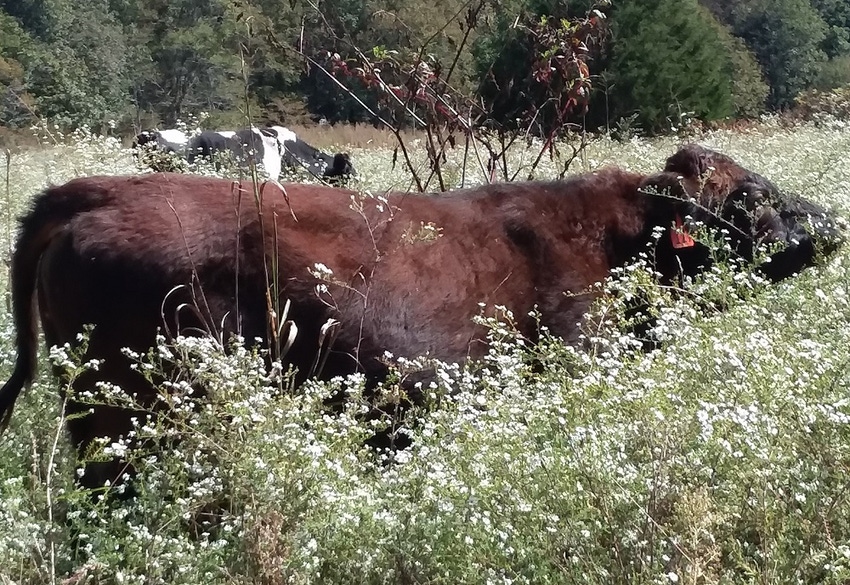
It always rains somewhere. If you don’t like the weather just hang around and it will change. This year the weather is different from last year. Next year will be a swap from what we have experienced this time.
I am writing in late August and it’s been wet for most of the year. We normally have six to eight weeks annually when the evaporation rate exceeds the rainfall. It hasn’t happened in 2017. Wonder what 2018 holds? It’ll be different.
I normally start planning for winter in late May. Last year was different since our acreage has been reduced by 60%. Last year we carried 55,000 pounds of cattle through fall and winter without any hay, and no substantial rain until after Thanksgiving. This year we needed to be down to 20,000 pounds before mid-October and this might be too late for that many cattle. I’ll talk about this later.
My point is that animal health is what cattle producers are selling. Yes, I agree that we need to use cattle to self-harvest the excess solar production of forage for increased productivity, but only healthy critters are capable of getting it done efficiently. Every day I attempt to spend several minutes viewing our animals, focusing on the entirety of the herd while ridding myself of distraction and paying special attention to the edges.
A positive animal condition is always a necessity for breeding. Cattle that are not on the gain should not be expected to cycle and breed. When it is time to breed they need to be doing it. With the possible exception of mid-winter, calves and steers should be gaining weight and condition or need to be shipped. There are extremely few positive examples of holding cattle that are not getting better while waiting on the market to improve. Cattle that are finished can be processed and wintered in the freezer much more efficiently and cheaper than they can in a yard or the pasture.
Winter is a good deal when you have lots of standing grass in front of cattle that can winter healthy and cheap. The gains in weight and condition will come during the growing season. When they are ready to sell they need to leave.
Here is what we look for and monitor on a daily basis. I don’t like surprises.
Response of the cattle to the truck. How fast do they come for supplement? The slower the better, within reason.
Are they eager for the supplement and how aggressive is consumption?
How much forage did they leave yesterday?
What is their fill? At 11 a.m. I want the cattle to be full. By 4 p.m. I want them to be really full. When cattle leave water they should be full.
If they are in the shade, 80% or more should be chewing cud and act satisfied and happy. Cattle that rise should stretch and poop manure that stacks two to three inches high and is peanut butter consistency.
Yesterday’s graze should have manure piles every six feet if it was completely recovered before grazing. If you are not moving once or more daily this is not going to happen.
Are eyes bright? How about the skin and hair?
What is the fly load? What was it yesterday? Is it getting worse every day? We do not count flies but we do pay attention. Horn and horse and deer flies can and will cause money problems if they get out of control.
Do the cattle need more or less grass than they got yesterday? Are we coming back before dark today? What time tomorrow? How many days can they back-graze? What does it look like behind them three days, five days, eight days? How about two, four, six and eight weeks back?
Are there any cattle out?
Is there any heat activity?
Are the calves present and looking and acting happy? Are they full?
Is anybody lame? What about udders? Are any udders tight? Any lumps or bumps?
What about tomorrow? When, where and how?
As the growing season gets on its back side, conditions are a lot different than they were in mid June or early July. We are now in jungles with lots of growth that is seven feet tall. If you are not in completely recovered, tall, diversified pasture by the end of August, I would be surprised if you winter without hay in most of the country. As I write in August, we are losing 15 minutes of daylight every week. We like to move cattle onto dry grass that has several hours of good sun prior to the move.
The jungle components have lots of plant diversity, and the digestibility can be high but can also make major changes every few days.
Hopefully, many of you all are understanding why I advocate moving cattle at least once daily. It improves your ability to enjoy this business and it gives the cattle the ability to properly function in the natural model.
Remember that by the time we reach mid August and September we need to see the winter forage in front of us or have a marketing plan to execute in the near term. In the more brittle upper mid-west and much of the intermountain area, planning for winter may need to be made 16 to 24 months in advance. Every location is different. Every year is different. But the natural principles are basically the same. How we function and operate during the non-growing season (how much money we fail to spend) is or can be our biggest profit center. Each one we miss is gone.
About the Author(s)
You May Also Like






